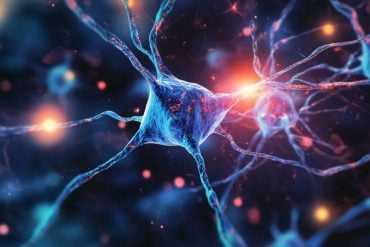Summary: Researchers have developed a new model of early embryonic brain development. The model, called MiSTR, allows researchers to create tissue that contains different brain regions and place them next to each other. The model produces results similar to embryonic brain development at five weeks post-fertilization.
Source: Lund University
Stem cell researchers at Lund University in Sweden have developed a new research model of the early embryonic brain. The aim of the model is to study the very earliest stages of brain to understand how different regions in the brain are formed during embryonic development. With this new insight, researchers hope to be able to produce different types of neural cells for the treatment of neurological diseases more efficiently. The study is published in the journal Nature Biotechnology.
In order to develop stem cell treatments for neurological diseases such as Parkinson’s Disease, epilepsy and stroke, researchers must first understand how the human brain develops in the embryonic stage. With knowledge of how neural cells are formed at different developmental stages, researchers have the opportunity to develop new stem cell therapies more quickly in the laboratory.
“The challenge is that there are thousands of different sub-types of neural cells in the human brain, and for each disease we need to be able to produce exactly the right type of neural cell”, says Agnete Kirkeby, researcher at the Wallenberg Centre for Molecular Medicine and the Department of Experimental Medical Science at Lund University.
Studies on how each individual neural cell forms in the embryo during brain development are essential for the researchers to be able to understand how to produce these specific cells in the laboratory.
Research on the early development of the human brain, from five days after the fertilisation of the cell to approximately seven weeks, have so far been difficult as researchers have not had access to human embryonic tissue from these early stages of development. Therefore, nearly all knowledge of the earliest development of the brain is based on studies in flies, chickens and mice.
“However, the composition of the human brain differs greatly from the animals’ brains. Therefore, this period in the development of the human brain has long been viewed as the black box of neurology”, says Agnete Kirkeby.
Together with colleagues from the University of Copenhagen and bioengineers Thomas Laurell and Marc Isaksson from the Faculty of Engineering at Lund University, Agnete and her team have now created a model that mimics the early developmentalstages of the human brain through the use of stem cells. The stem cells are cultivated in a custom-built cell culture chamber where they are exposed to an environment which resembles the environment in the early embryonic brain.
“In the laboratory model called MiSTR (Microfluidic-controlled Stem cell Regionalisation), we can create tissue that contains different brain regions next to each other, similar to an embryonic brain approximately four to five weeks after fertilisation.”
“We start with a small group of cells that will form the brain and instruct the cells by exposing them to a gradient of a specific growth factor (WNT) so that they form different regions of the brain. Our model is better than previously published models because it is much more reproducible and contains more brain regions. We can now use it to study unknown characteristics in the early development of the human brain”, explains Agnete Kirkeby.
Agnete Kirkeby believes that the new method may be used to investigate how brain cells in the early embryonic stages react to certain chemicals surrounding us in our daily lives.

“This is a significant step forward for stem cell research. For the first time, we now have access to tissue that resembles the early embryonic brain and can therefore study processes behind brain development in a way that has not been possible before. We can for instance use it for testing how chemical substances in our environment might impact on embryonic brain development.” explains Kirkeby.
Another aim for the future is to use the model to create a complete map of the development of the human brain. This will help to speed up the development of new stem cell treatments for neurological diseases.
“Once we have the map we will also become better at producing human neural cells in the laboratory that could be used for transplantations, regenerative therapy and to study the brain’s function as well as different disease states. It took us ten years to develop a stem cell treatment for Parkinson’s disease because our methods were dependent on trial and error. Our goal is that this process will be much faster in the future for other diseases”, concludes Agnete Kirkeby.
About this neuroscience research article
Source:
Lund University
Media Contacts:
Agnete Kirkeby – Lund University
Image Source:
The image is in the public domain.
Original Research: Closed access
“Modeling neural tube development by differentiation of human embryonic stem cells in a microfluidic WNT gradient”. by Pedro Rifes, Marc Isaksson, Gaurav Singh Rathore, Patrick Aldrin-Kirk, Oliver Knights Møller, Guido Barzaghi, Julie Lee, Kristoffer Lihme Egerod, Dylan M. Rausch, Malin Parmar, Tune H. Pers, Thomas Laurell & Agnete Kirkeby.
Nature doi:10.1038/s41587-020-0525-0
Abstract
Modeling neural tube development by differentiation of human embryonic stem cells in a microfluidic WNT gradient
The study of brain development in humans is limited by the lack of tissue samples and suitable in vitro models. Here, we model early human neural tube development using human embryonic stem cells cultured in a microfluidic device. The approach, named microfluidic-controlled stem cell regionalization (MiSTR), exposes pluripotent stem cells to signaling gradients that mimic developmental patterning. Using a WNT-activating gradient, we generated a neural tissue exhibiting progressive caudalization from forebrain to midbrain to hindbrain, including formation of isthmic organizer characteristics. Single-cell transcriptomics revealed that rostro-caudal organization was already established at 24 h of differentiation, and that the first markers of a neural-specific transcription program emerged in the rostral cells at 48 h. The transcriptomic hallmarks of rostro-caudal organization recapitulated gene expression patterns of the early rostro-caudal neural plate in mouse embryos. Thus, MiSTR will facilitate research on the factors and processes underlying rostro-caudal neural tube patterning.
Feel Free To Share This Neuroscience News.







